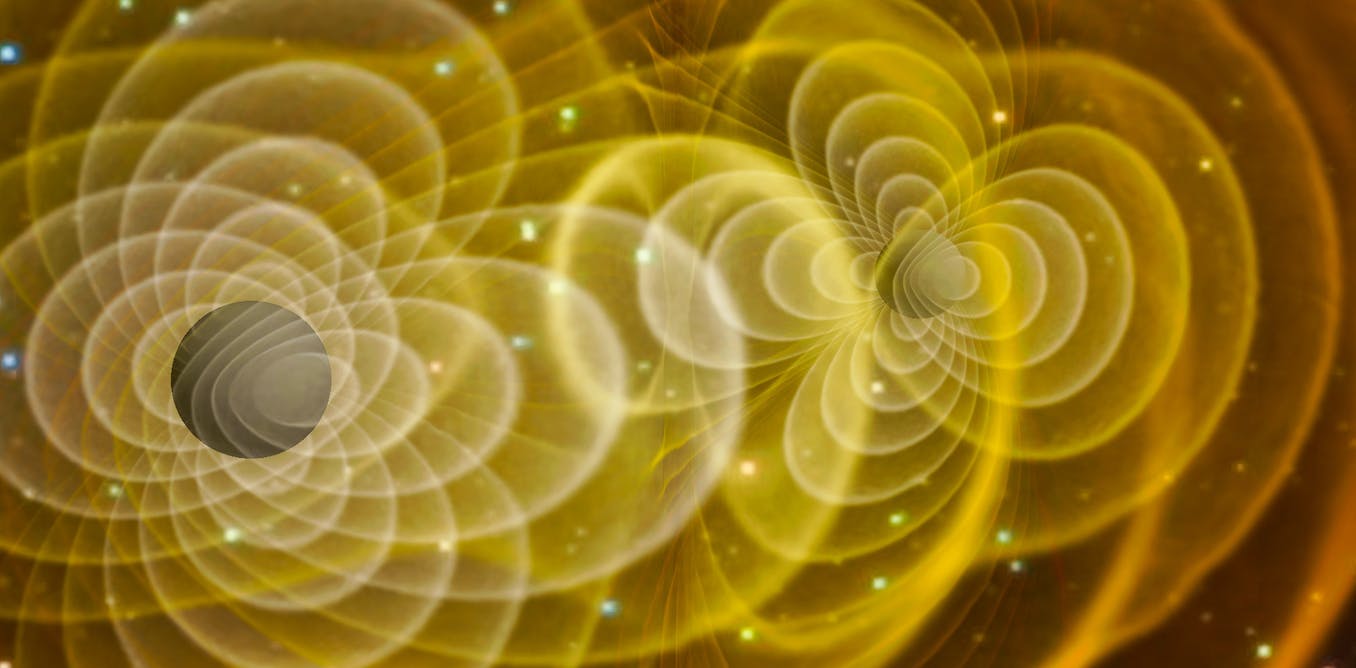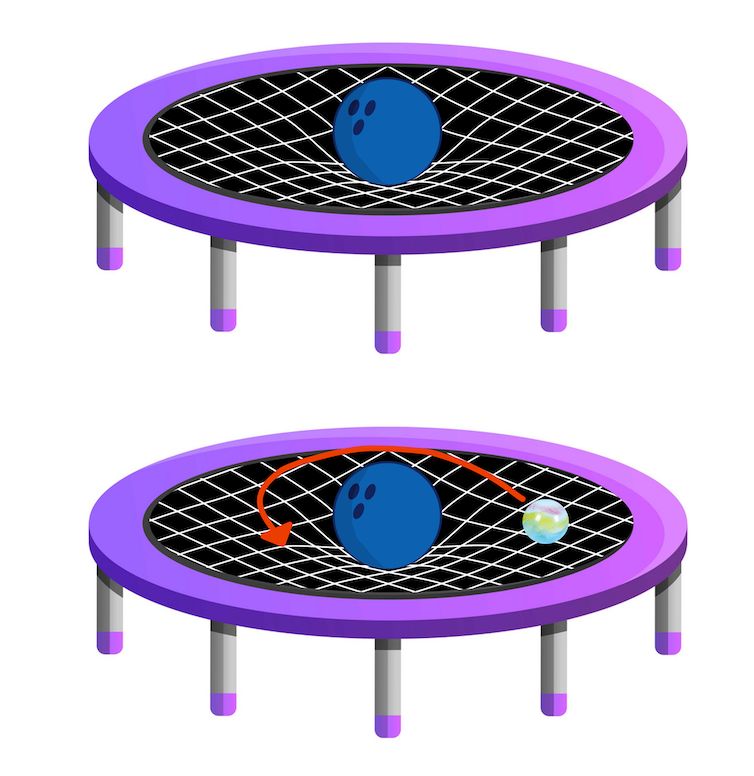What are gravitational waves?

3D visualisation of gravitational waves produced by two orbiting black holes. Image: Henze/NASA
In summary
Analysis for The Conversation Curious Kids section by Dr Sara Webb from the Centre of Astrophysics and Supercomputing
What are gravitational waves? – Millie, age 10, Sydney
What a great question Millie!
To answer this we have to travel back in time, to the year 1916. This is the year famous physicist Albert Einstein published his general theory of relativity.
Einstein had figured out how to explain gravity within the Universe using maths. Gravity is the force that keeps us on Earth, and Earth orbiting around the Sun. Until 1916 there had been many theories to try and explain what gravity was and why it exists. But Einstein suggested that gravity was the bending of something called space-time.
You can think of space-time like the fabric of the Universe. It’s what makes up the space we live in. Without it we wouldn’t have a Universe, and that wouldn’t be very fun.
A space-time trampoline
Curved space-time is responsible for the effects of gravity. A trampoline is a great way for us to picture this on a flat surface.
Imagine you place a heavy bowling ball in the centre of a trampoline – its mass bends the fabric, and it creates a dip. Now, if we tried to roll a marble across the trampoline, it would roll inwards and around the bowling ball.
That’s all gravity is: the distortion of the space-time fabric, affecting how things move.

If a heavy thing like a bowling ball stretches the trampoline, a marble will roll towards it in a circle. Image: Author provided
This is what Einstein’s famous equations helped to explain – how we can expect space-time to move under different conditions. We know that in the Universe, nothing stands still. Everything is always moving, and when objects speed up through space-time, they can create small ripples, just like a pebble in a pond.
These ripples are what we call gravitational waves. Our Universe is likely full of these tiny waves, like an ocean with waves moving in all different directions.
But unlike the ocean, gravitational waves are incredibly small and won’t be rocking Earth about. When first predicted by Einstein, he doubted if we’d ever be able to detect them because of how teeny tiny they should be.
I would love to know what he would think today. Not only have we detected gravitational waves, but we’ve detected 90 unique events! This is one of the biggest achievements in physics, and how they did it was nothing short of amazing.
Squeeze and stretch
When a gravitational wave passes through Earth, it squeezes or stretches the whole planet in the direction it travels. If we tried to measure it with something like a ruler, the ruler would appear to be the same length because the numbers on the ruler would also be stretched or squeezed, and wouldn’t change.
But scientists have a trick: they can use light, because light can only travel a certain distance over a certain time. If space is stretched out, the light has to travel a little bit farther, and takes longer. Vice versa for when space in squeezed.
The trick to knowing if space has been squeezed or stretched is to measure it in two directions, and calculate the difference. Unfortunately for us it isn’t something that is easy to measure.
The difference in the distance we’re looking for is 1,000 times smaller then a really tiny particle called a proton. To really blow your mind, our bodies have around 10 octillion protons (10,000,000,000,000,000,000,000,000,000).
It’s an insanely small change we needed to detect, but thankfully clever scientists and engineers figured out a way to do it, and you can learn more about these detectors in the video below.
Gravitational waves have given us new eyes to our Universe, allowing us to “see” things like black holes and neutron stars crashing together – because we can finally detect the tiny ripples they create.

This article was originally published on The Conversation.
-
Media Enquiries
Related articles
-

- Technology
- Science
- Engineering
Victorian students drive green energy transition through international hydrogen competition
Swinburne’s KIOSC, in collaboration with Horizon Educational and Gippsland Tech School, co-hosted the Hydrogen Grand Prix in Melbourne.Friday 26 July 2024 -

- Science
Skin, scales and fish tails: using collagen to turn fish guts into gold
New research from Swinburne could transform the sector by converting high value collagen proteins from seafood by-products into cosmetics, food, and pharmaceuticals.
Tuesday 02 July 2024 -

- Astronomy
High school students work with Swinburne astronomers on the future of space
Swinburne’s Youth Space Innovation Challenge has inspired over 330 Australian teenagers to pursue a career in STEM.
Friday 26 July 2024 -

- Science
- Engineering
Submarines in the future could self-identify cracks and self-heal thanks to Swinburne researcher
Thanks to the work of Dr Nisa Salim from Swinburne University of Technology’s School of Engineering, future submarines could self-identify microcracks and self-heal using a new kind of carbon fibre reinforced polymer composites.
Monday 17 June 2024 -

- Science
Inaugural Swinburne-CSIRO Indigenous Research Fellow joins national water quality forecasting project
Swinburne University of Technology has appointed spatial ecologist Associate Professor Sally Waller as its inaugural Swinburne-CSIRO Indigenous Research Fellow...
Thursday 13 June 2024

